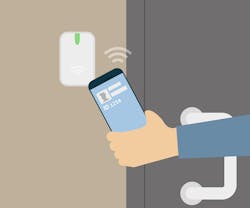Would it surprise you to know that access control technology dates back four millennia? Unbelievable, yet true. Archeologists uncovered a 4,000-year-old wooden lock in the Khorsabad palace ruins near Mosul, Iraq. Known as a pin-tumbler type, it evolved as a practical solution for opening a barred door from the outside. The ancient Romans improved on the design with more sophisticated iron locks and metal keys. Today we’ve reinvented the lock-and-key model using more secure electronic locks. We’ve introduced touch keypads, magnetic strip and microchip card readers and more. So what’s next on the secure entry horizon? One innovation gaining momentum in the industry is mobile credentialing. Another is biometric analysis.
Mobile Key Distribution System: A New Model for Access Control
Mobile credentialing replaces today’s access control cards with a mobile key distribution system that allows authorized users to simply request access to specific doors with the touch of a button on their smartphone: be it an iPhone/iOS, Android, Windows phone or other model. In essence, forgetting or losing one’s card key becomes a thing of the past.
What makes a mobile credentialing system so advantageous? As a network-based, non-proprietary solution, it is highly scalable, flexible and cost effective. Users can choose their hardware and software components separately, combining the best-of-breed credentialing technologies that match their needs and budget. They can store all their user mobile key data locally or encrypt and archive it in the cloud for greater security. They can even opt for easy turnkey solutions to expedite implementation and minimize costs typically associated with installing standard card credentialing systems.
Changing the Credentialing Business Model
New technologies often spur new business models to manage them. Such is the case with mobile credentialing. While customers traditionally managed the activation/deactivation of access control cards in house, mobile credentialing systems offer them the opportunity to simplify management by offloading this time-consuming task to a secure third party. Using the cloud, integrators can issue mobile credentials, terminate credentials and control authorizations for their customers, generating recurring monthly revenues for themselves based on the services provided. This is also a win for the customer because they can better manage their costs for employee security.
Where Mobile Credentialing Has the Great Potential for Adoption
The potential applications for mobile credentialing are varied and many. Here are just a few examples:
- Unattended deliveries. In facilities where deliveries are made after hours, the delivery drivers can now use their smartphone to open doors and deposit the products in a secure area. Different drivers on any given delivery would now have mobile access to multiple destinations.
- Rental properties. Mobile credentialing technology is ideal for vacation rentals where a guest’s credentials are managed securely and sent to them prior to their arrival. Think about it. The mobile phone in your pocket already has the credentialing you need to open the door to your vacation home! If your trip is delayed and you arrive later than expected, there’s no need to wait at the front desk or office for a key.
- Guard services companies. The alarm comes in and the company dispatched a guard to the location to check on the situation. Instead of sifting through a bunch of keys to find the one that unlocks that facility, the guard simply taps his smartphone to unlock the door. The mobile credentialing system generates an audit trail of the entry so the customer and the guard services company have a record of who responded to the call. It’s a win for all concerned and an efficient way to manage multiple end-customer locations.
It’s clear that mobile credentials are more efficient than traditional keys for access to properties, whether they be hotels, retail stores, office buildings or other venues. Starwood Hotels is a case in point. They decided to provide guests with mobile keys on their smartphones so that they could bypass the long lines at the front desk to get access control cards for their rooms. Not only did this expedite check-in, it also allowed the hotel to do away with costly and time-consuming card issues and make the customer experience a lot easier.
Biometric Scanning: Another Innovative Entry Control System
Facial, palm and fingerprint scanning also hold great promise as alternative entry control mechanisms. Enormous strides have been made in recent years in the field of biometric screening. Not only have facial recognition algorithms become increasingly more accurate and reliable, but today’s HDTV-quality network video cameras deliver far greater image resolution and processing power than ever before. The power to process facial analysis (or other biometric scans) in real-time makes these system ideal for gatekeeping and post-event forensics in secure areas such as ports, borders, power grid facilities, water treatment facilities and other critical infrastructure.
As IP technology continues to improve, providing an ever more robust backbone of connectivity and mobility, it paves the way for smarter, edge-based devices that don't need to rely on server-based technology. This creates the foundation for more agile and responsive solutions that will be far less expensive to acquire, deploy and maintain than their predecessors.
Where Access Control Innovations Are Leading
According to projections by IHS, cloud services for access-control-as-a-service are projected to exceed $530 million by 2018 and $1.8 billion by 2025, globally. These figures should inspire more traditional security integrators to start revamping their business model and begin selling more cloud-based services and features going forward.
As bandwidth availability continues to increase and bandwidth costs continue to drop, video- surveillance-in-the-cloud is becoming far more prevalent. Smarter cameras that can operate without the need for local servers are also helping to shift the traditional surveillance landscape to a cloud model.
Even the government has begun adopting a cloud model for managing their security system resources.
Where is all this innovation leading? In my opinion, we’ll soon be seeing many more businesses moving their services and support to the cloud. We are a mobile society and there is no un-ringing that bell. The number of ways we employ the devices in our pockets to make our lives easier and safer virtually knows no limit. Therefore it’s inevitable that mobile applications will continue to expand exponentially making the cloud the critical platform for innovation in the foreseeable future.



